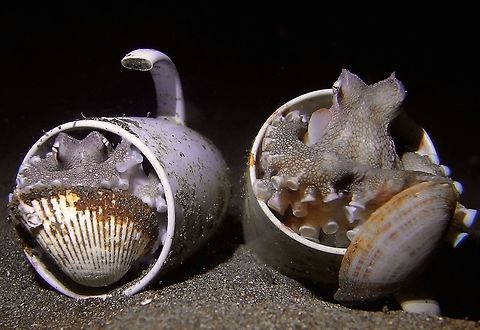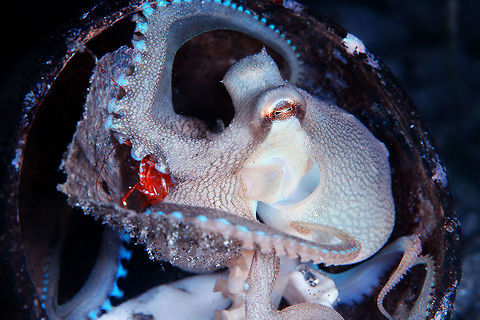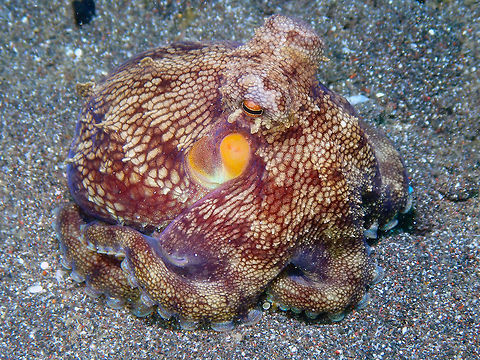
Appearance
The main body of the octopus is typically 8 centimeters long and including the arms, approximately 15 centimeters long. The octopus displays a typical color pattern with dark ramified lines similar to veins, usually with a yellow siphon. The arms are usually dark in color, with contrasting white suckers. In many color displays, a lighter trapezoidal area can be seen immediately below the eye.
Behavior
The coconut octopus is found on sandy bottoms in bays or lagoons. It frequently buries itself in the sand with only its eyes uncovered.In March 2005, researchers at the University of California, Berkeley, published an article in ''Science'' in which ''A. marginatus'' was reported to show bipedal locomotion. It is one of only two octopus species known to display such behavior, the other species being ''Abdopus aculeatus''. According to the article, this behavior was discovered in an area off Sulawesi, Indonesia, where the sandy bottom was littered with coconut shells. The bipedal motion appears to mimic a floating coconut.
Researchers from the Melbourne Museum in Australia claimed the coconut octopus uses tools for concealment and defense by gathering available debris to create a defensive fortress. This behavior was observed in individuals in Bali and North Sulawesi in Indonesia. The researchers filmed the octopus collecting coconut half-shells discarded by humans from the sea floor. They were then carried up to 20 meters and arranged around the body of the octopus to form a spherical hiding place similar to a clam-shell.

Habitat
The coconut octopus is found on sandy bottoms in bays or lagoons. It frequently buries itself in the sand with only its eyes uncovered.In March 2005, researchers at the University of California, Berkeley, published an article in ''Science'' in which ''A. marginatus'' was reported to show bipedal locomotion. It is one of only two octopus species known to display such behavior, the other species being ''Abdopus aculeatus''. According to the article, this behavior was discovered in an area off Sulawesi, Indonesia, where the sandy bottom was littered with coconut shells. The bipedal motion appears to mimic a floating coconut.
Researchers from the Melbourne Museum in Australia claimed the coconut octopus uses tools for concealment and defense by gathering available debris to create a defensive fortress. This behavior was observed in individuals in Bali and North Sulawesi in Indonesia. The researchers filmed the octopus collecting coconut half-shells discarded by humans from the sea floor. They were then carried up to 20 meters and arranged around the body of the octopus to form a spherical hiding place similar to a clam-shell.
References:
Some text fragments are auto parsed from Wikipedia.